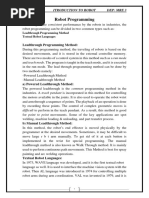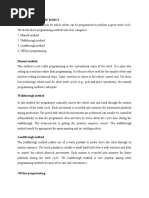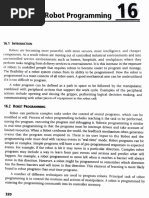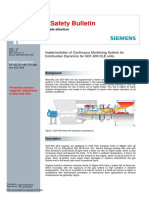0 ratings0% found this document useful (0 votes)
2 viewsrobot programming teach method
Robot programming involves teaching robots the paths to execute tasks, utilizing either Teach/Leadthrough methods or textual robot languages. Teach/Leadthrough methods include Powered and Manual programming, where the robot's movements are recorded through direct manipulation or a teach pendant. While these methods are accessible and simple, they also have disadvantages such as slow programming speed and challenges in integrating sensor data.
Uploaded by
tohebax556Copyright
© © All Rights Reserved
Available Formats
Download as PDF, TXT or read online on Scribd
0 ratings0% found this document useful (0 votes)
2 viewsrobot programming teach method
Robot programming involves teaching robots the paths to execute tasks, utilizing either Teach/Leadthrough methods or textual robot languages. Teach/Leadthrough methods include Powered and Manual programming, where the robot's movements are recorded through direct manipulation or a teach pendant. While these methods are accessible and simple, they also have disadvantages such as slow programming speed and challenges in integrating sensor data.
Uploaded by
tohebax556Copyright
© © All Rights Reserved
Available Formats
Download as PDF, TXT or read online on Scribd
You are on page 1/ 2
Robot programming by teach method
Robot programming is concerned with teaching the robot the path that the robot must execute in moving
parts or tools from one location in the workspace to another. Robot programming methods is of two
types: Teach/Leadthrough methods and, Textual robot languages.
The teach/leadthrough methods require the programmer to move the manipulator through the desired
motion path and that the path be committed to memory by the robot controller.
Robot programming with textual languages is done somewhat like computer programming. The
programmer types in the program using a high-level English-like language and transfers it to robot
controller. The controller runs this program and controls the robot.
TEACH/LEADTHROUGH PROGRAMMING METHODS
In Teach/Leadthrough programming, the robot is moved through the desired motion path in order to
record the path into the controller memory. There are two methods of Teach/Leadthrough programming:
1. Powered Teach/Leadthrough, and 2. Manual Teach/Leadthrough
1. Powered Teach/Leadthrough:- The powered Teach/Leadthrough method makes use of a teach
pendant to control the points in space. Each point is recorded into memory for subsequent play back
during the work cycle. The teach pendant is usually a small handheld control box with combinations of
buttons and display to regulate the robot’s physical movements and programming capabilities.
It is largely limited to point-to-point motions rather than continuous movement because in space. A large
number of industrial robot applications consist of point-to-point movements of the manipulator. These
include part transfer tasks, machine loading and unloading, and spot welding.
2. Manual Teach/Leadthrough:- In the manual Teach/Leadthrough method, the programmer physically
grasps the robot arm (and end effector) and manually moves it through the desired motion cycle. If the
robot is large and awkward to physically move, a special programming apparatus is often substituted for
the actual robot. This apparatus has the same geometry as the robot, but it is easier to manipulate during
programming. A teach button is often located near the wrist of the robot (or the special programming
apparatus) which is depressed during those movements of the manipulator that will become part of the
programmed cycle.
The manual Teach/Leadthrough method (also sometimes called the ‘walkthrough’ method) is more used
for continuous-path programming where the motion cycle involves smooth complex curvilinear
movements of the robot arm. The most common example of this kind of robot application is spray
painting, in which the robot’s wrist, with the spray painting gun attached as the end effector, must execute
a smooth, regular motion pattern in order to apply the paint evenly over the entire surface to be coated.
Continuous arc welding is another example in which continuous-path programming is required and this
is sometimes accomplished with the manual Teach/Leadthrough method.
Advantages of teach/leadthrough programming methods
• Easily accessible
• In concordance with the actual position of equipment and pieces
• Simplicity in programming so that even an operator with virtually no qualification can do it.
Disadvantages of Teach/Leadthrough Programming Methods
• Slow movement of the robot while programming
• Program logic and calculations are hard to program
• Difficult to incorporate sensor data
• Suspension of production while programming
• Cost equivalent to production value
• Poorly documented.
You might also like
- SQ416V-SQ420V-SQ420W-SQ625W-SQ416Q-SQ420Q - Wiring Manual PDFNo ratings yetSQ416V-SQ420V-SQ420W-SQ625W-SQ416Q-SQ420Q - Wiring Manual PDF153 pages
- Robot Programming: by 143-Akash Sanghvi 144-Varun Sharma 145-Gopesh Raval 146-Nitesh DawaniNo ratings yetRobot Programming: by 143-Akash Sanghvi 144-Varun Sharma 145-Gopesh Raval 146-Nitesh Dawani10 pages
- OIE 751 ROBOTICS Unit 4 Class 5 (20-10-2020)No ratings yetOIE 751 ROBOTICS Unit 4 Class 5 (20-10-2020)13 pages
- Unit - Vi: ROBOT PROGRAMMING - A Robot Program May Be Defined As A Path inNo ratings yetUnit - Vi: ROBOT PROGRAMMING - A Robot Program May Be Defined As A Path in15 pages
- Programming Methods For Robots: Apurva Joshi M.Tech (RE)No ratings yetProgramming Methods For Robots: Apurva Joshi M.Tech (RE)21 pages
- Robot Programming: Amirkabir University of Technology Computer Engineering & Information Technology DepartmentNo ratings yetRobot Programming: Amirkabir University of Technology Computer Engineering & Information Technology Department35 pages
- Basics of Robotics Ch 5 Notes and Imp. Questions_copy(0)No ratings yetBasics of Robotics Ch 5 Notes and Imp. Questions_copy(0)11 pages
- Unit IV Robot Kinematics and Robot ProgrammingNo ratings yetUnit IV Robot Kinematics and Robot Programming23 pages
- Unit IV Robot Kinematics AND Robot Programming: Prepared byNo ratings yetUnit IV Robot Kinematics AND Robot Programming: Prepared by21 pages
- Robot Programming: Specification of A Series of Basic ActionsNo ratings yetRobot Programming: Specification of A Series of Basic Actions20 pages
- Development of a Programming Teaching-Aid Robot withNo ratings yetDevelopment of a Programming Teaching-Aid Robot with12 pages
- Leadthrough Programming and Motion Interpolation60% (5)Leadthrough Programming and Motion Interpolation18 pages
- The Software Programmer: Basis of common protocols and proceduresFrom EverandThe Software Programmer: Basis of common protocols and proceduresNo ratings yet
- Circuit Theory Analysis Lecture Notes All Unit PDF100% (2)Circuit Theory Analysis Lecture Notes All Unit PDF259 pages
- Creating Work Breakdown Structure & It's ImportanceNo ratings yetCreating Work Breakdown Structure & It's Importance37 pages
- K. Radhakrishna, S. Seshan, and M. Seshadri, Dendrite Arm Spacing and Mechanical Properties of Aluminum Alloy Castings, Aluminum, Vol 38, 1979No ratings yetK. Radhakrishna, S. Seshan, and M. Seshadri, Dendrite Arm Spacing and Mechanical Properties of Aluminum Alloy Castings, Aluminum, Vol 38, 19793 pages
- No Voltage Release (Tamperproof) : Manual Reset Construction 1/4No ratings yetNo Voltage Release (Tamperproof) : Manual Reset Construction 1/46 pages
- 3.4 Culmann's Graphical Construction of Earth Pressure0% (1)3.4 Culmann's Graphical Construction of Earth Pressure13 pages
- Satya Packaging: Quality Test Report of PaperNo ratings yetSatya Packaging: Quality Test Report of Paper1 page
- L09 Electrical Design of Overhead Transmission LinesNo ratings yetL09 Electrical Design of Overhead Transmission Lines28 pages
- Program Structure of CNC Machines According To PALNo ratings yetProgram Structure of CNC Machines According To PAL16 pages

























































































